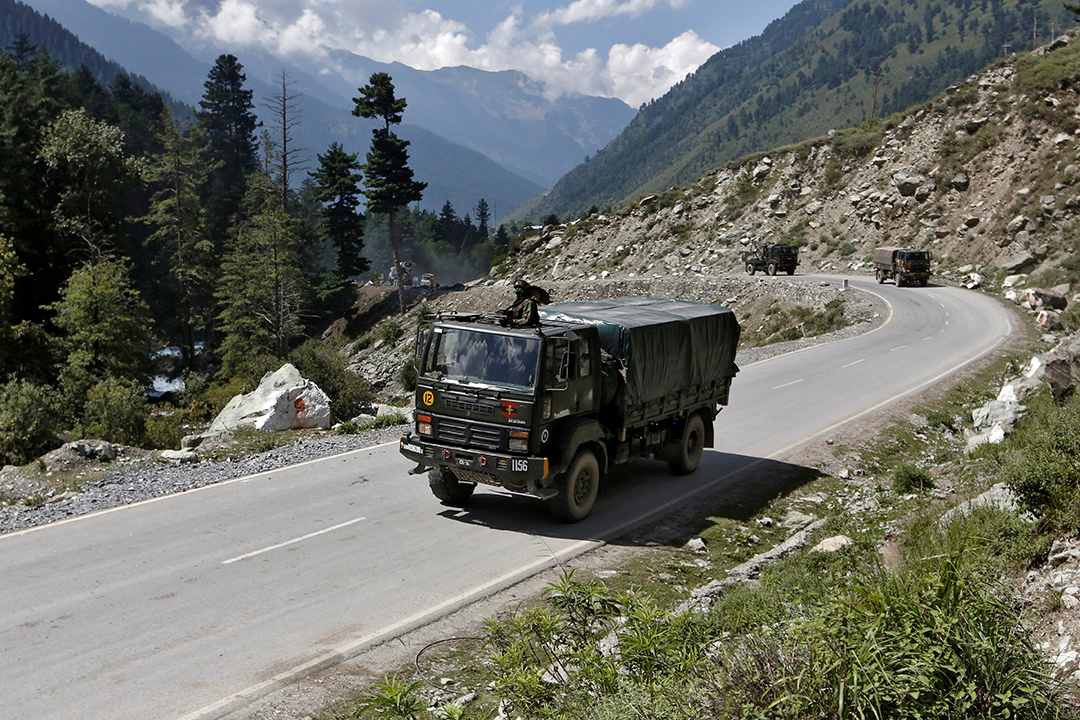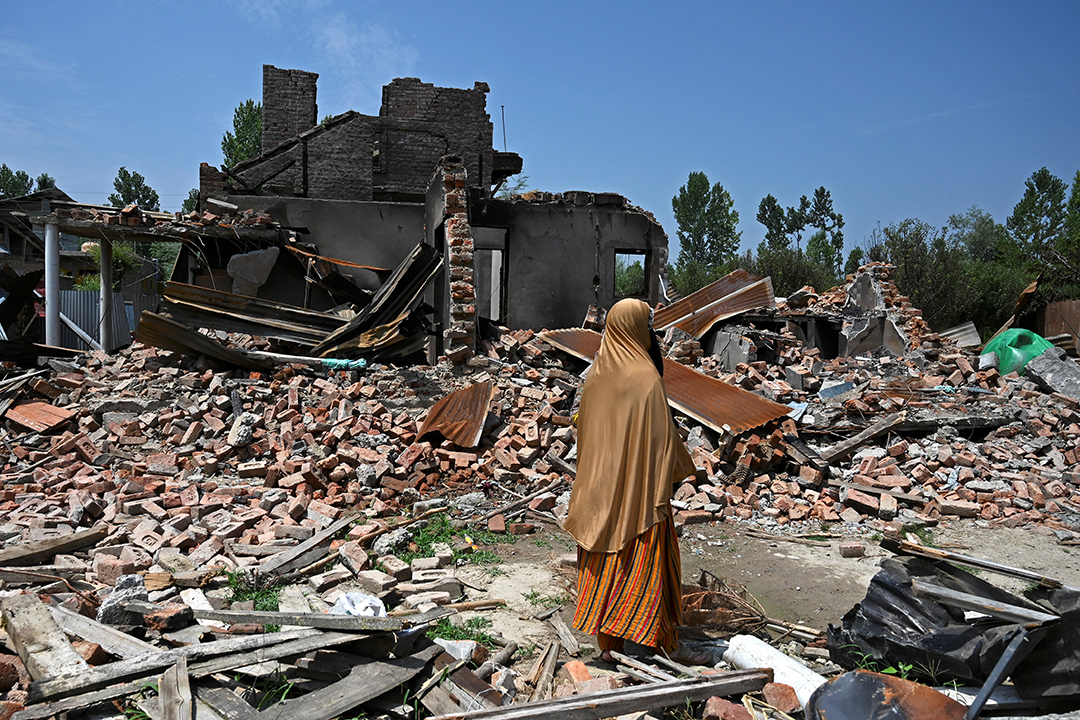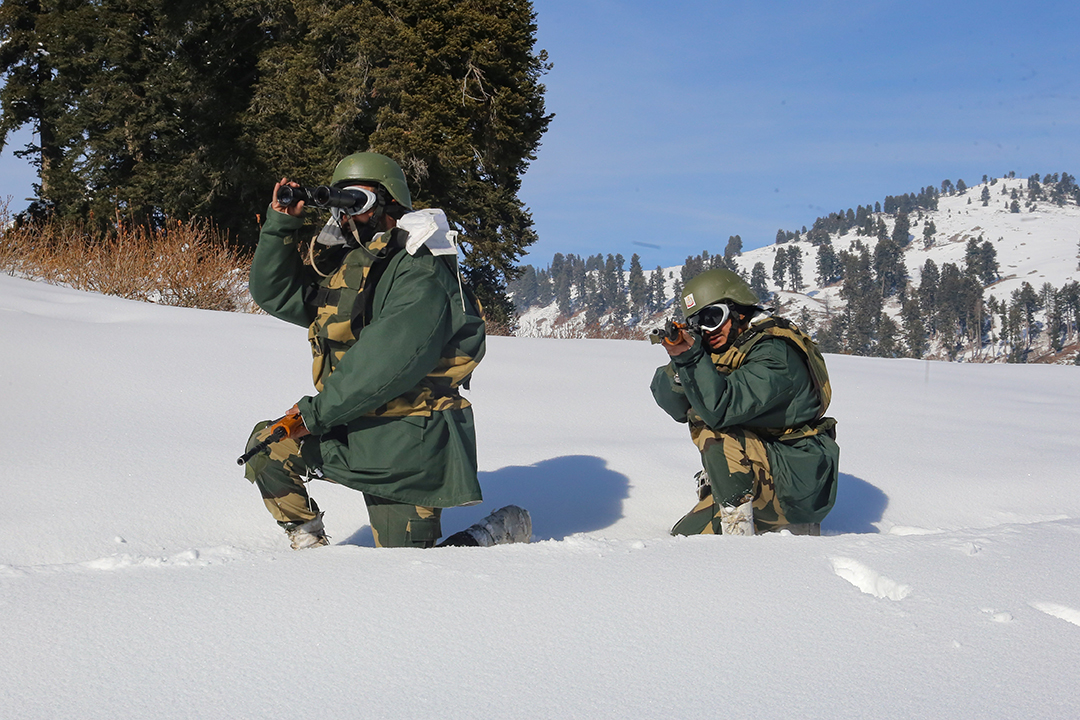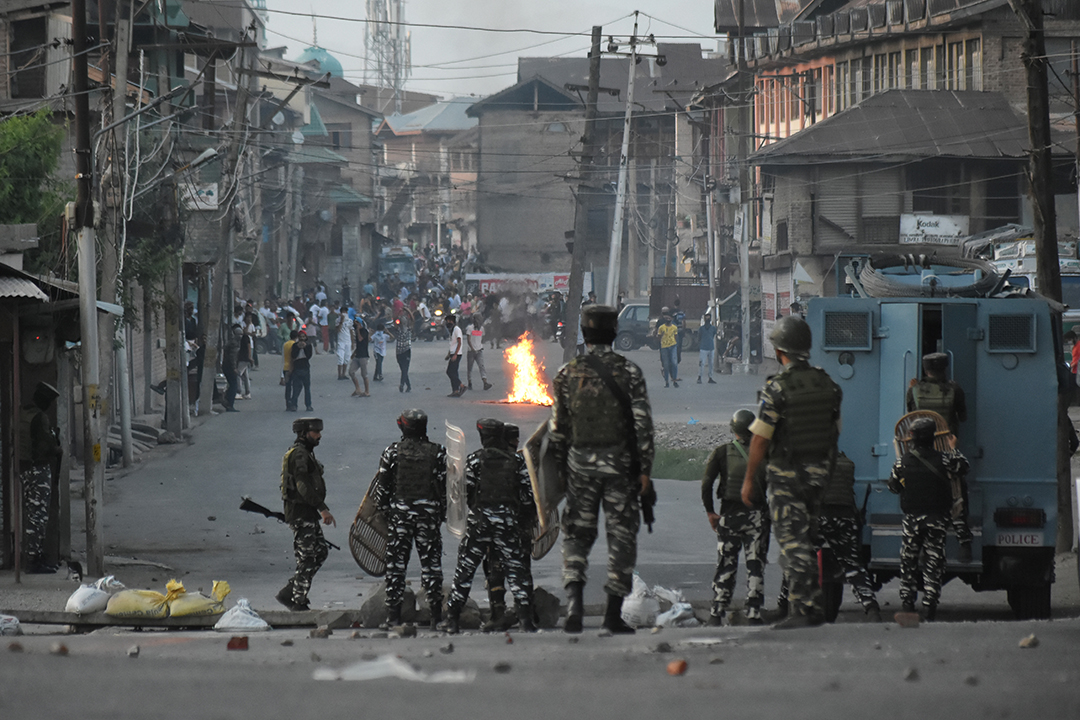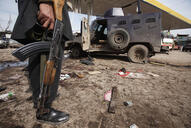The conflict between India and Pakistan arose out of the 1947 Partition of British India, enshrined in the Indian Independence Act. The Partition established a Muslim-majority Pakistan and a Hindu-majority India and provided the diverse regions of Jammu and Kashmir the opportunity to choose which country to accede to. The maharaja (Kashmir’s monarch) at the time initially sought independence, as Kashmir was neglected and subjugated for centuries by conquering empires. However, he ultimately agreed to join India in exchange for help against invading Pakistani herders, triggering the Indo-Pakistani War of 1947-48. The Karachi Agreement of 1949 temporarily ended violence in the Jammu-Kashmir region by establishing a cease-fire line (CFL) overseen by members of a UN truce sub-committee.
Tensions simmered until a skirmish between border controls escalated to a full-blown war in 1965. In 1971, India and Pakistan fought another brief war over East Pakistan, with Indian forces helping the territory gain independence, resulting in the establishment of present-day Bangladesh. India and Pakistan attempted to usher in a new era of bilateral relations with the 1972 Simla Agreement, which established the Line of Control (LOC), a provisional military control line that split Kashmir into two administrative regions. However, in 1974, the conflict took on a new dimension with the introduction of nuclear weapons, raising the stakes of any confrontation. That year, India tested its first nuclear weapon, triggering a nuclear arms race that would see Pakistan reach that same milestone two decades later.
In 1989, Pakistan capitalized upon a burgeoning resistance movement in Indian-administered Kashmir to undermine Indian control, reigniting tensions and beginning decades of communal violence. Despite a recommitment to the LOC in 1999, Pakistani soldiers crossed the LOC, sparking the Kargil War. Although both countries have maintained a fragile cease-fire since 2003, they regularly exchange fire across the contested border. Both sides accuse the other of violating the cease-fire and claim to be shooting in response to attacks.
On November 26, 2008, fears that India and Pakistan would once again head towards direct military confrontation abounded after militants laid siege to the Indian capital of Mumbai. Over three days, one hundred sixty-six people were killed, including six Americans. Both India and the United States blamed Pakistani-based Lashkar-e-Taiba (LeT), a militant group with alleged ties to the Inter-Services Intelligence (ISI)—Pakistan’s primary intelligence agency—for perpetrating the attack. Although evidence suggested linkages between LeT and facets of the Pakistani government, India’s response was even-handed. Instead of escalating tensions, the Indian government took the diplomatic route by seeking cooperation with the Pakistani government to bring the perpetrators of the attack to justice, paving the way for improved relations.
In 2014, there were hopes that India would pursue meaningful peace negotiations with Pakistan after India’s then-newly elected Prime Minister Narendra Modi invited Pakistani Prime Minister Nawaz Sharif to attend his inauguration. After a brief period of optimism, relations turned sour once more in August 2014 when India canceled talks with Pakistan’s foreign minister after the Pakistani high commissioner in India met with Kashmiri separatist leaders. A series of openings continued throughout 2015, including an unscheduled December meeting on the sidelines of the UN Climate Change Conference in Paris. This was followed by a meeting between national security advisors in Bangkok a few days later, where the Kashmir dispute was discussed. In the same month, Prime Minister Modi made a surprise visit to Lahore to meet with Prime Minister Sharif, the first visit of an Indian leader to Pakistan in more than a decade.
Momentum toward meaningful talks came to an end in September 2016, when armed militants attacked a remote Indian Army base in Uri, near the LOC, killing eighteen Indian soldiers in the deadliest attack on the Indian armed forces in decades. Indian officials accused Jaish-e-Mohammad (JeM), another group with alleged ties to ISI, of being behind the attack. In response, the Indian military announced it had carried out “surgical strikes” on terrorist camps inside Pakistani-administered Kashmir while the Pakistani military denied that any such operation had taken place.
This period was marked by an uptick in border skirmishes that began in late 2016 and continued into 2018, killing dozens and displacing thousands of civilians on both sides of the Line of Control. In 2017, more than three thousand cross-border strikes were reported, while nearly one thousand were reported in the first half of 2018. Militants launched attacks in October 2017 against an Indian paramilitary camp near Srinagar and, in February 2018, against an Indian army base in the Jammu region, which killed five soldiers and a civilian. During this time, violent demonstrations and anti-India protests calling for an independent Kashmir also continued; over three hundred people, including civilians, Indian security forces, and militants, were killed in attacks and clashes in 2017. After months of Indian military operations targeting both Kashmiri militants and demonstrations, India announced in May 2018 that it would observe a cease-fire in Kashmir during the month of Ramadan for the first time in nearly two decades; operations resumed in June 2018. Later in May, India and Pakistan formally agreed to a cease-fire along the disputed Kashmir border that would restore the terms of their 2003 agreement.
In February 2019, an attack on a convoy of Indian paramilitary forces in Pulwama, Indian-administered Kashmir, killed at least forty soldiers. The attack, claimed by the Pakistani militant group JeM, was the deadliest in Kashmir in three decades. India retaliated by conducting an air strike that targeted terrorist training camps within Pakistani territory; these were answered by Pakistani air strikes on Indian-administered Kashmir. The exchange escalated into an aerial engagement, during which Pakistan shot down two Indian military aircraft and captured an Indian pilot; the pilot was released two days later.
In August 2019, following a deployment of tens of thousands of additional troops and paramilitary forces to the region, the Indian government moved to revoke Article 370 of the Indian constitution, removing the special status of Jammu and Kashmir. The abrogation of Article 370 removed Kashmir’s ability to determine its own property and settlement laws, forcing Kashmiris to abide by Indian property and customary law and effectively diminishing their autonomy. The ruling not only angered Kashmiris but was also viewed as a “grave injustice” by Pakistan. The removal of Article 370 signified the more aggressive approach of the Modi government to integrate Kashmir into India through a doctrine of Hindu nationalism.
Following the revocation of Article 370, India-administered Kashmir remained under lockdown for over a year, with internet and phone services intermittently cut off and thousands of people detained. While India claimed the shutdown to be a crucial step toward security and economic development, Kashmir has instead become more dangerous, and economic investment has declined. Much to the dismay of Kashmiri locals, the Indian Supreme Court upheld the legality of the abrogation of Article 370 in December 2023, cementing the removal of Indian-administered Kashmir’s special status.
Violence along the LOC peaked in 2020, with more than four thousand reported cross-border firings. India also observed an increase in militant recruitment despite a slight drop in militant activity. However, tensions eased following a February 2021 cease-fire that has since been held. Nonetheless, New Delhi continues to push for centralized control over Indian-administered Kashmir.
The United States has made several attempts to mediate India-Pakistan tensions with mixed results. In the 1960s, the United States and the United Kingdom conducted six rounds of talks to resolve the Kashmir dispute to little avail. Conversely, the Clinton administration’s intervention in the Kargil War of 1999 was largely credited with averting nuclear war and laying the groundwork for post-Cold War relations between the United States and India. The United States’ parallel relationships with India and Pakistan have limited its credibility as an honest broker in the dispute. The U.S.-Pakistan relationship was primarily founded upon their mutual interests in counterterrorism and regional stability following 9/11. However, the U.S. withdrawal from Afghanistan in 2021, further compounded by Pakistan’s domestic unrest and increasing ties with China, has thrown the relationship into flux. U.S.-India relations, on the other hand, have strengthened in recent years. Denoted a “strategic partnership” in 2005, the United States and India have deepened their defense cooperation, particularly under the Trump administration. Other international attempts to resolve India-Pakistan tensions, notably via the UN Security Council, have also been unsuccessful.
Separately, China has increasingly waded into the volatile region, stepping up its own border dispute with India in the Aksai Chin and Arunachal Pradesh border regions. In 2020, clashes broke out in the Galwan Valley over territory in Ladakh, and another skirmish occurred in 2022 near the countries’ Line of Actual Control (LAC) in Arunachal Pradesh. In April 2023, India pushed back against China’s renaming of thirty places in Arunachal Pradesh, calling the region an “integral” part of India. Other than at its shared disputed borders, China poses a significant threat to India through its collaboration with Pakistan. In recent years, China has increased its military, political, and economic cooperation with Pakistan, namely through China’s joint investment with Pakistan in the China-Pakistan Economic Corridor (CPEC). Infrastructural projects under CPEC include hydroelectric power stations and fiber-optic cabling along the disputed Kashmir territory. The fighting and intimidation tactics in the region have prompted greater militarization along the disputed borders, as India now fears the prospect of a conflict with China and Pakistan.
In 2022 and 2023, the Indian central government cracked down on independent media in the region, redrew the electoral map to privilege Hindu-majority areas in Kashmir, and held a G20 tourism meeting in Srinagar. Targeted killings against Hindus have become more frequent, motivating some to flee and protest government policies. In response to the uptick in violence, the Modi government has taken an increasingly militarized response that threatens to exacerbate the current political crisis in Kashmir.
At the May 2023 Shanghai Cooperation Organization summit in India, the foreign ministers of India and Pakistan traded barbs over Kashmir, missing an opportunity to improve relations. Furthermore, the actions of the Pakistani military against Imran Khan in 2023 have raised concerns that Pakistani political turmoil will fuel the arguments of Indian hardliners and hinder peace. Indeed, a month after the summit, tensions heightened after U.S. President Joe Biden and Modi made a joint statement at the White House calling for Pakistan to “take immediate action” against extremist groups operating in its territories and to bring the perpetrators of the 2008 attacks in Mumbai to justice. The Pakistan Foreign Ministry responded by summoning the U.S. deputy chief of mission to reprimand the United States for encouraging “India’s baseless and politically motivated narrative against Pakistan” and reiterate the importance of continued U.S.-Pakistan counterterrorism cooperation. In December, India formally requested the extradition of Hafiz Saeed, a suspect in the 2008 Mumbai attacks currently imprisoned in Pakistan on terrorism-financing charges. Pakistan rejected India’s request, citing the lack of a bilateral extradition treaty between the two countries.
Meanwhile, violence along the India-Pakistan border continues. In late June 2023, the Pakistani army accused Indian forces of killing two civilians along the LOC, the first such occurrence since both sides agreed to a cease-fire in 2021. A second similar incident occurred less than a month later, according to police in Pakistan-administered Kashmir. Most recently, Indian and Pakistani soldiers exchanged gun and mortar fire across the disputed border in November, killing an Indian border guard. Pakistan has also accused India of committing extrajudicial killings on its territory, a statement which the Indian foreign minister labeled as “malicious anti-Indian propaganda.” The accusations came after the murder of two Pakistani nationals: Muhammad Riaz, who was shot outside a mosque in Pakistan-administered Kashmir in September for his alleged ties with LeT, and Shahid Latif, a suspected member of JeM and critical figure involved in the Pathankot attack on an Indian airbase in January 2016 who was killed in October in Pakistan’s Punjab region. Around that same time, a bombing killed more than fifty-nine civilians in Pakistan’s Balochistan province, which Pakistan claimed was orchestrated by India’s intelligence agency.
In the coming weeks, instability in Kashmir may worsen as India begins the largest election in its history. From April 19 to June 1, more than 900 million people will vote to elect the members of India’s lower house of parliament, the 18th Lok Sabha. In Jammu and Kashmir, this will be the first election held since the revocation of its autonomy in 2019. Prime Minister Modi’s Bharatiya Janata Party (BJP) aims to win its first seats in the region, arguing that they have fostered stability and economic development. In pursuit of this goal, Modi made his first official visit to the region’s capitol since 2019 in March, announcing the launch of several development projects and accusing opposition parties of misleading the Kashmiri people and promoting separatism in the area. However, continued militant violence and Modi’s heavy-handed tactics to quell unrest in Kashmir may prove challenging to overcome.

